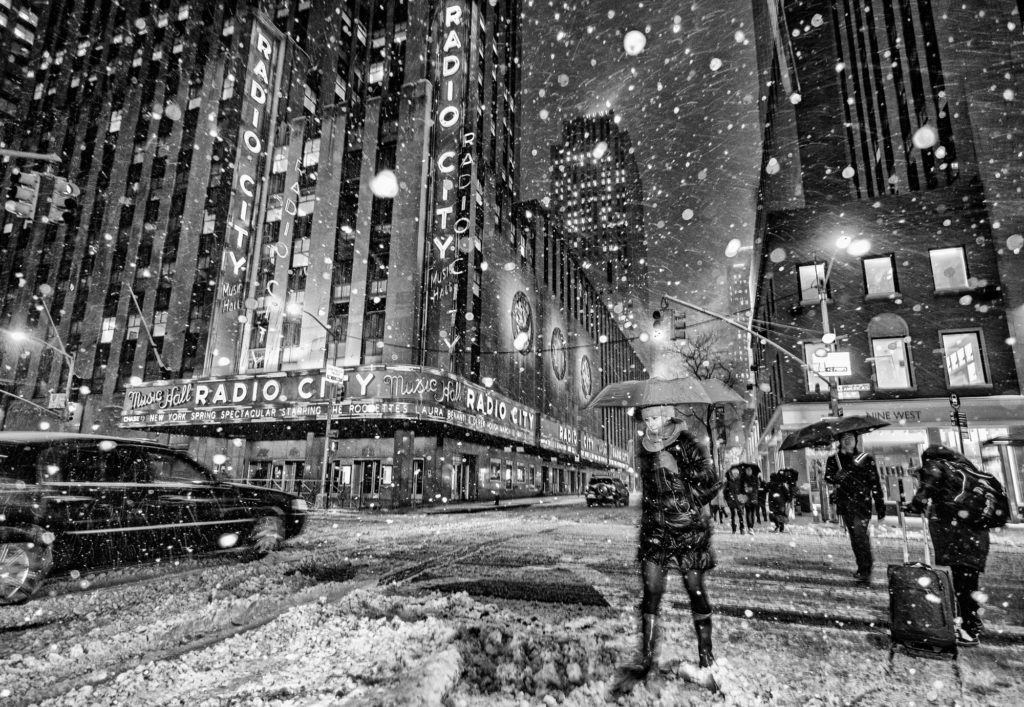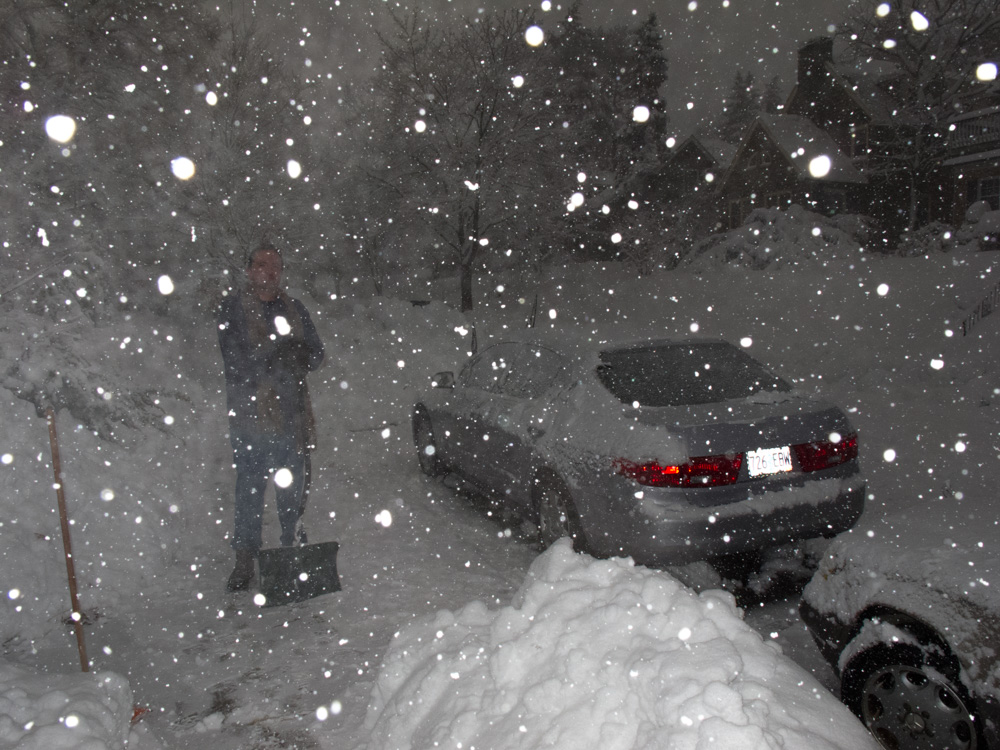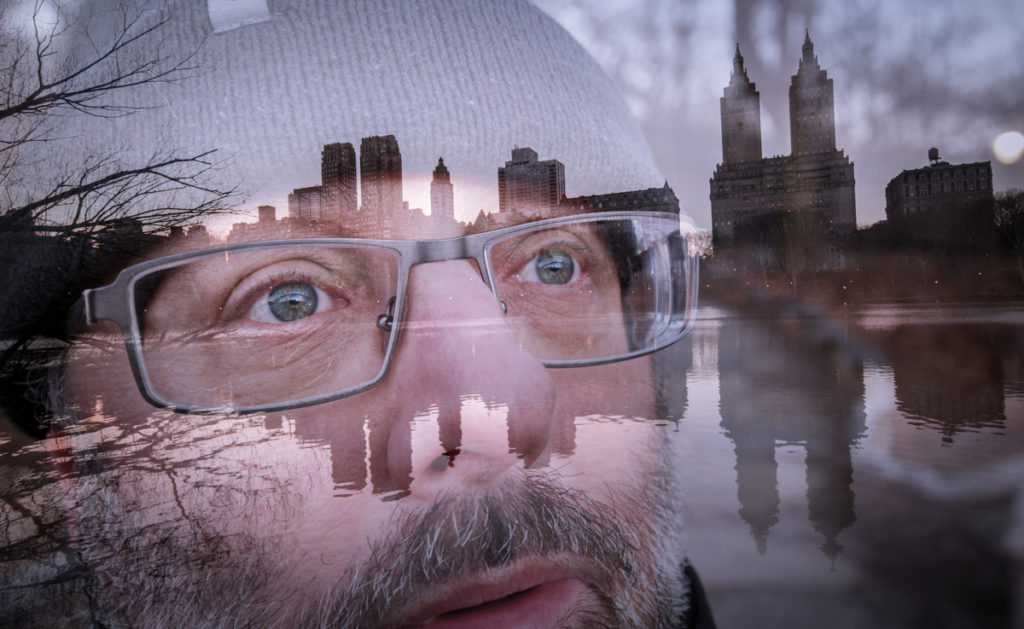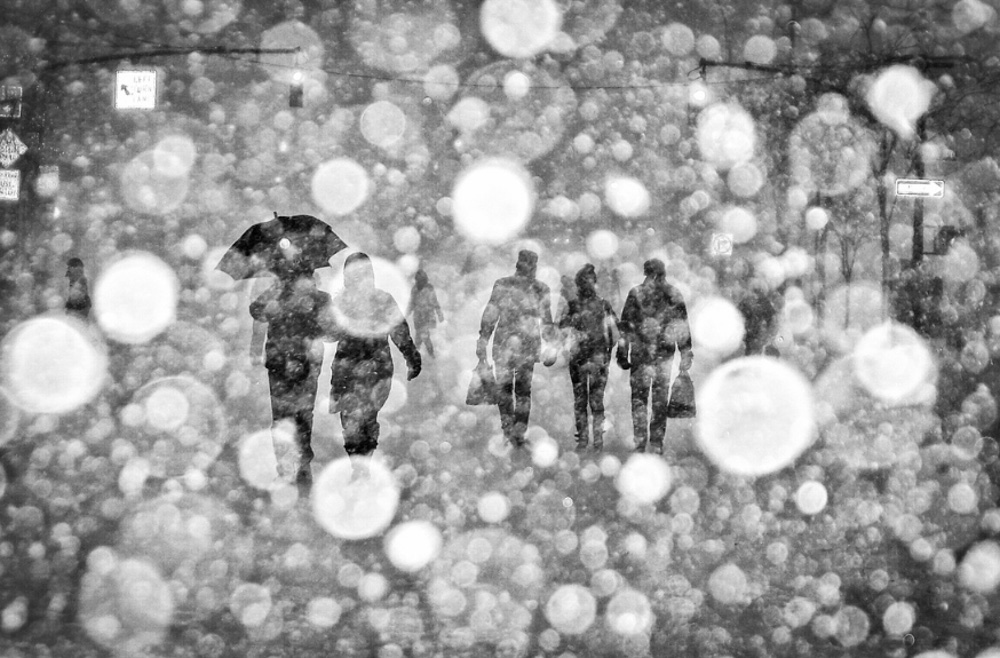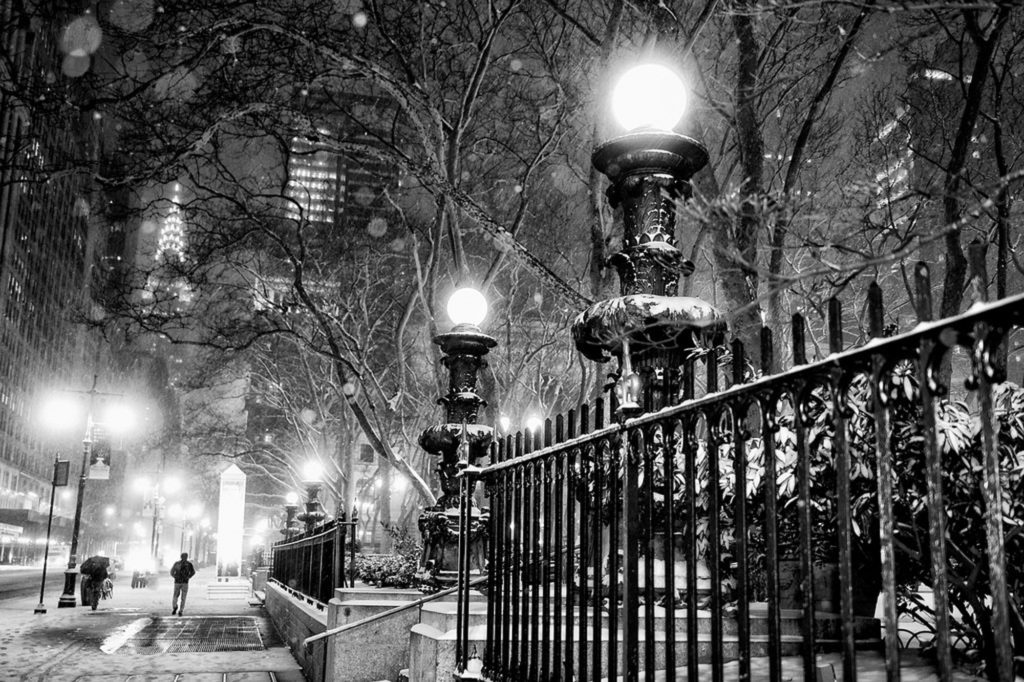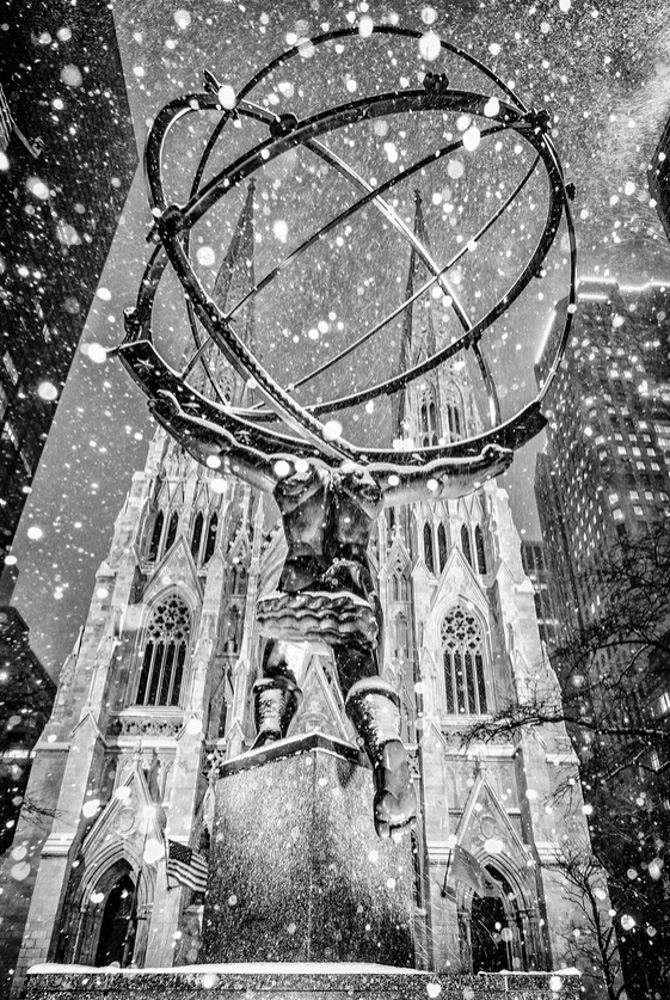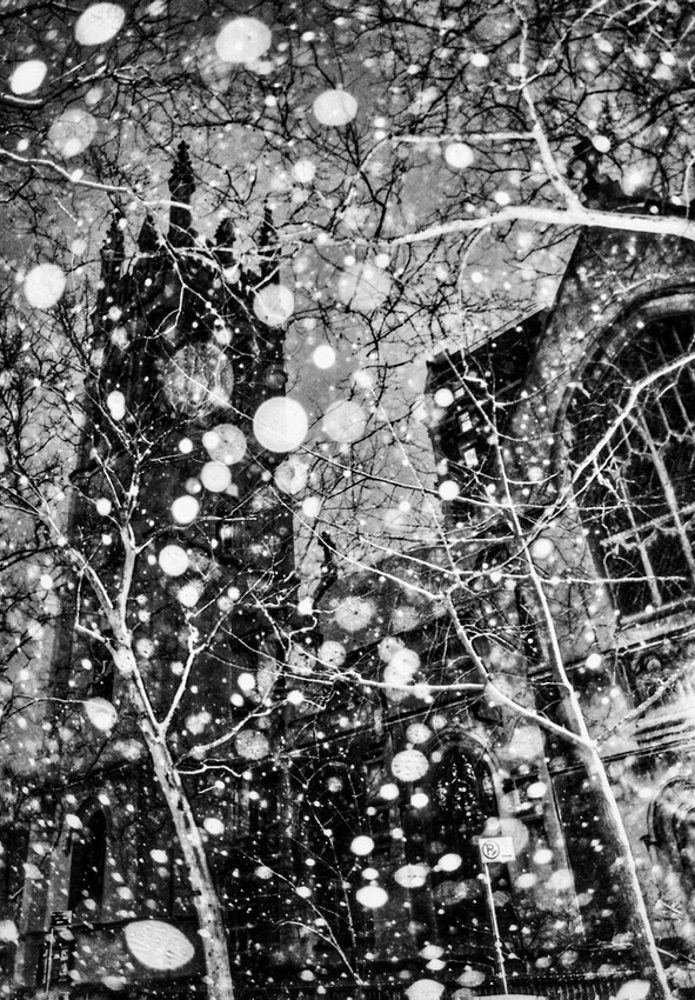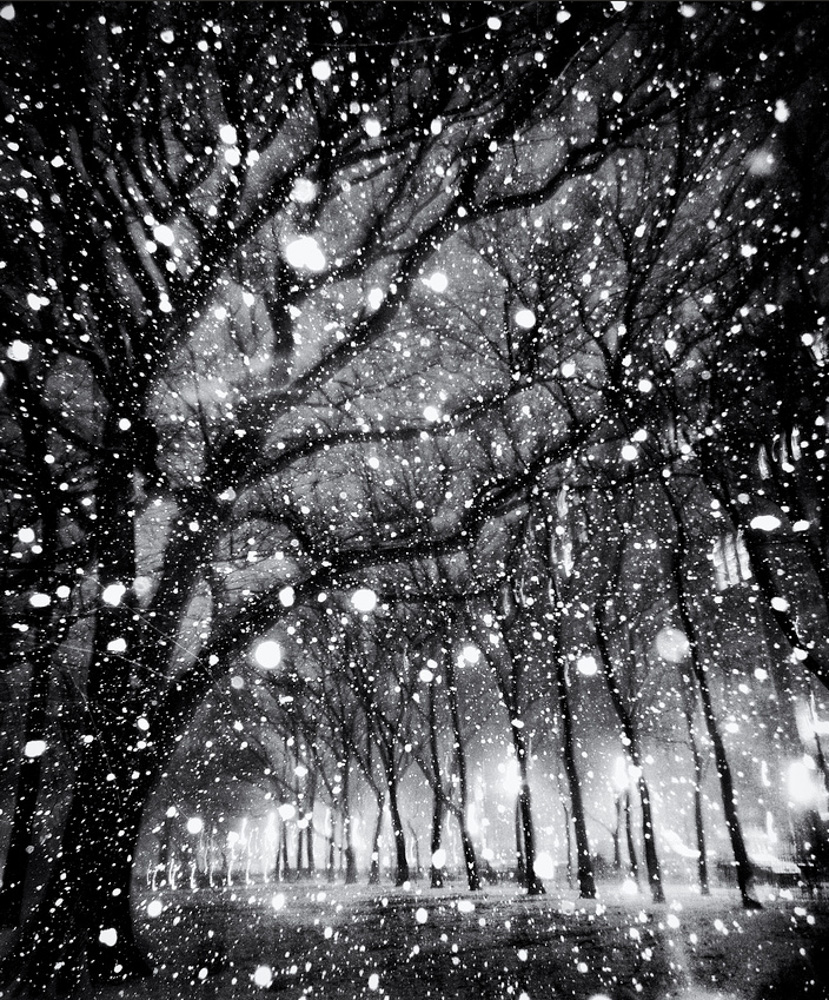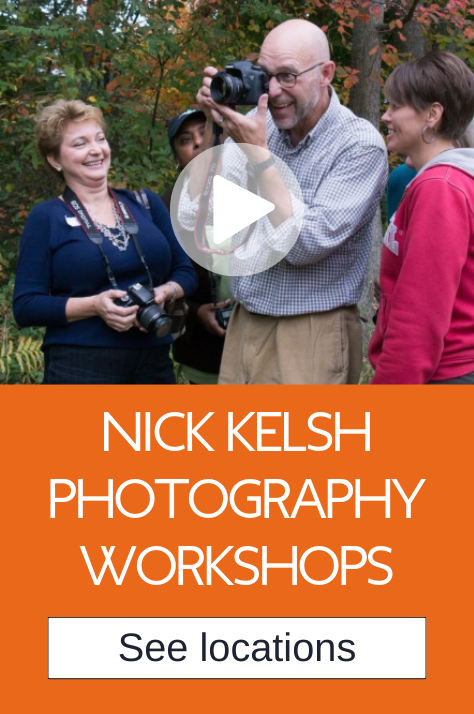The forecast says a big blizzard is heading my way. In this case “my way” means that millions of people are going to get nailed on the East Coast of the United States this week—I live in Philadelphia.
As a North Dakota boy I have a lot of snow photography under my belt. So speaking as an expert, I recently told you know how NOT to photograph snow. Make sure you turn your flash OFF, I said. It will light up the snowflakes close to your camera and you won’t like it, I said. Your pictures will be full of hot white spots I warned.
This is the photograph I originally published demonstrating how NOT to do it. Wrong, wrong, wrong and again wrong, Nick.
Then I met Russ Rowland . (His website is totally inspirational. Check it out. It’s time well spent.)
Russ is a big time commercial photographer in New York City. He never leaves home without a camera and he always leaves home when it snows. Russ loves snow and he photographs it with his flash ON to wild acclaim which is saying a lot; when your snow photos stand out in a city full of photographers you’ve accomplished something. He especially loves it when it snows at night. (Imagine how many photographers hit the streets with their camera during a NYC blizzard. 10,000? 100,000?)
If you’re one of the fortunate millions that going to get snowed on soon I know you’re itching to do this. So look at Russ’s photographs and do your best to guess his settings. He can’t really tell you what to set your camera on—there are so many variables. Russ and I both recommend that you go out and give this a try. We will, however, try to get you in the ballpark before you go.
It’s taken Russ years to come up with the perfect combinations of shutter speed, f-stop, and flash brightness. Basically, there are snow falls and then there are snow falls. Every snow event is different. The size and quantity of the snowflakes is the big factor. There are great big clumpy snowflakes and then there are little ice balls and there’s everything in between. You and I—like Russ— are left to guess and experiment and play with our settings which, if you think about it, is all the more fun.
So let’s start with the overall exposure. If you go outside at night you’re going to have to turn up your ISO. Turning up the ISO makes your camera more sensitive to light. You almost have to do that whenever you’re shooting in dim light. Let’s say there’s some existing light from the city or car headlights or streetlights. Those of us in the business call that dim lighting. So before you turn the flash on you want to establish the foundation exposure/overall exposure.
I’m thinking you might want to start with ISO 1600. If you think about it, you need to expose properly for whatever’s beyond the twelve-foot reach of that little flash regardless of whether the flash is on or not. ISO 1600 should get you into the hand-held shutter speed range of 1/30th of a second. Yes, you may pick up a little digital noise by turning up the ISO, but a snow storm is a fairly friendly high ISO subject. Snow falls are already a little visually noisy. In other words, that snow is going to hide some high ISO defects. How convenient.
I highly recommend manual exposure for this exercise. So, you put your camera on manual exposure and take a light reading. (If you don’t know how to do that, you clearly need to take my Going Manual Course. Just saying.)
You establish an exposure using your light meter that results in photographs that aren’t too dark or too bright for whatever light happens to be out there. Of course, New York City streets at night are one thing (bright) and a little farm town in Upstate New York is another (not so bright). You just need to go with the flow.
I’m thinking you are going to be in the 30th of a second at f4 range. Believe me, I’m guessing right along with you here. Fine. Done. Let’s start with a 30th of a second at F4 at ISO 1600.
Believe it or not, this is what good photographers do a lot of the time; they guess. Russ Rowland guesses and he knows what he’s doing! It’s okay to guess when you’re shooting photographs. In fact, I highly recommend it. You learn a lot regardless of whether you guess right or wrong…actually more when you guess wrong.)
Next, you need a good blast of light coming directly from your camera. This flies in the face of every piece of advice I’ve ever given you about good lighting. That flash on your camera is going to produce the same lighting effect as the headlights on your car and for this particular circumstance that’s going to be okay. (I have actually put into writing that the very last place you want light coming from would be your camera so this snowfall scenario is an exception.) It’s going to light up the snowflakes close to your camera and let the snowflakes in the background fall off into darkness. The overall exposure you have already established is going to expose for whatever’s in the background outside the range of the flash. This needs to make sense if you’re going to do this right.
Almost all of you have a built-in flash on your camera. For many of you, the way to turn the flash on is to push a little button on the top of your camera and the pop-up flash pops up. You may need to consult your instruction manual to see exactly how your camera handles this. But the basic idea is this:
1. You’re going to take a light reading and properly expose for the overall existing light of the scene. Then…
2. You’re also going to have your flash go off so it can light the snowflakes close to the camera without affecting the stuff in the far away background.
Many of you have cameras with a pop-up flash adjustment option in your camera settings. Theoretically, you can make it brighter or darker. Russell and I both feel that that adjustment is seriously unreliable to the point of being unusable. Not very helpful, I know, but true.
Here’s something to keep in mind: the whole idea here is to have overexposed white spots all over the picture (those would be the flash-blasted snowflakes) so you don’t have to go too crazy trying to “properly expose” for them. They are what they are—random white spots that hopefully look great.
I’ve noticed that Russ seems to shoot with a wide-angle lens a lot. That makes sense. Shooting with a wide-angle lens helps ensure that things are sharp – that is, if you want things to be sharp. (Wide angle lenses have more depth of field than longer lenses.) You may not want everything sharp. That’s your call. We are in complete total creative territory here. I’m hesitant to tell you to do anything here one way or the other. Artists at work, and all of that.
Something you are very likely going to want to do is focus the camera. I highly recommend that you use MANUAL focusing. Automatic focus is going to go a little schizo; it’s just not going to like all those fast-falling, focus-evading snowflakes. Trust me, get you camera on manual focus. Figure all of that out when you are sitting next to a roaring fireplace fire with a nearby brandy. Do not try and learn how to use your camera in foul weather at night. That’s a mistake.
Something that may happen for some of you when you use the flash and have a large lens on your camera is that the flash may actually throw a weird shadow in the foreground of your pictures and snowflakes near the camera will actually fall into that shadow.
There are a few things you could possibly do to get rid of that shadow. You could use a smaller lens. Or if possible, remove the lens shade from the lens you’re using and that might just do the trick. It’s often the lens shade that’s casting the shadow.
Or you could turn off the built-in flash and use a speedlite. (That’s a detachable flash unit that sits on top of the camera. It’s a separate purchase.) Because it’s higher and farther away from the lens it eliminates the shadow problem. Russell uses both. Depending on the lens he’s using and how much snow is coming down he switches back and forth between the built-in pop up flash and his speedlite.
A speedlite is also useful because you can dial in the strength of the blast by putting it on manual power. Manual power allows you to set it on full power or half power or 1/4 power and so on. Often times you can go way down to something like 1/16th power and that will be plenty of light for lighting white snowflakes that are close to the lens and that’s exactly what you’re doing. (The manual power setting on a speedlite has NOTHING to do with with manual exposure…totally unrelated. Manual exposure is a camera setting. Manual power on the speedlite simply means that you can set the speedlite to bright or dim and everything in between. This is a very important point.)
Russ keeps his choice of lenses simple. He pretty much sticks with one of two lenses. They are a 17-35mm or a 24-70mm. Depending on how hard the snow is coming down he generally shoots in the wider ranges of both of these lenses. If the snow is coming down hard he often doesn’t change lenses at all—he doesn’t want snow getting inside his camera. Makes complete sense.
Russ never uses a tripod for his snow shots. It’s just too much hassle. He wants to be light and mobile and his photographs taken without a tripod speak for themselves. He loves tripods, don’t get me wrong, but not for night snow photography.
There are some practical considerations when you’re shooting in heavy snow. First of all, if you get a couple big giant snowflakes glommed onto the front of your lens you’re probably not going to like that. They’re just going to show up in your photographs as foggy blobs.
So in the interest of keeping your lens dry I would keep it pointed at the ground until you’re ready to shoot photographs. I—like Russ—often wear a very loose fitting coat when I shoot photographs in the snow and tuck my camera in under my coat until I’m ready to use the camera.
The rest of your camera can handle a pretty good dose of snow without much problem, I have found. I really don’t think you need to go crazy try to keep your camera perfectly dry. Also, it never hurts to have a nice dry cloth with you to wipe it off as you go, however. I buy micro-fiber cloths at the auto-supply store by the dozen. They are handy all year long, as a matter of fact.
Russell is not big on those plastic camera raincoats and I agree. You end up wrestling with them in some harsh conditions and they’re just not worth the hassle. Russ does travel with a simple plastic bag to wrap around his camera just to keep it dry when he’s walking and not shooting. Rubber bands can be helpful.
Russ plans his snow outings days in advance. He keeps his eyes on the forecast and plans his locations carefully. He knows where he wants to be and when—within reason. He’s willing to dump the plan and go with the flow. Organized spontaneity seems to be a common thread among great photographers and Russ Rowland is certainly that.
For those of you that get out there and give this a try we’d love to see the results. Please post them on our Facebook page, How To Photograph Your Life.

